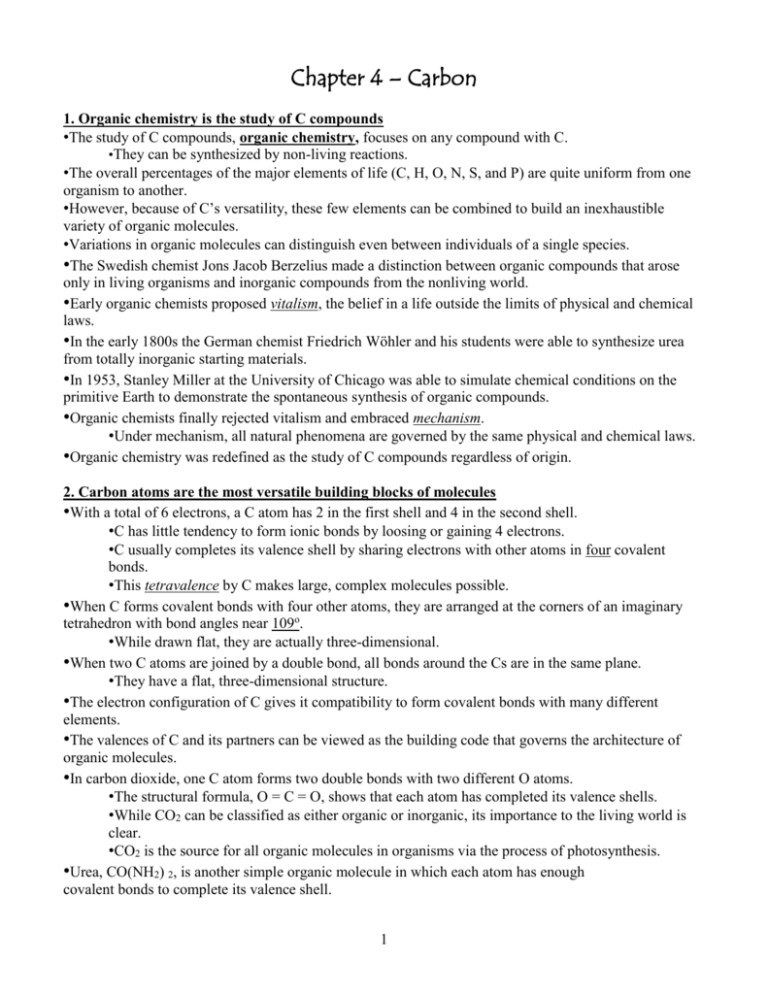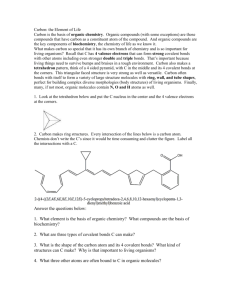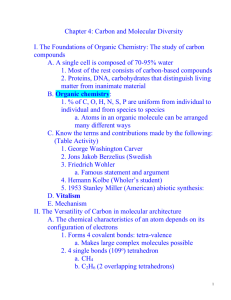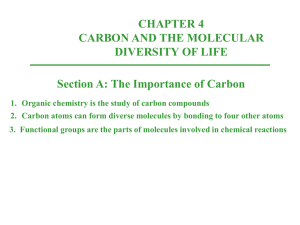Chapter 4 – Carbon
advertisement

Chapter 4 – Carbon 1. Organic chemistry is the study of C compounds •The study of C compounds, organic chemistry, focuses on any compound with C. •They can be synthesized by non-living reactions. •The overall percentages of the major elements of life (C, H, O, N, S, and P) are quite uniform from one organism to another. •However, because of C’s versatility, these few elements can be combined to build an inexhaustible variety of organic molecules. •Variations in organic molecules can distinguish even between individuals of a single species. •The Swedish chemist Jons Jacob Berzelius made a distinction between organic compounds that arose only in living organisms and inorganic compounds from the nonliving world. •Early organic chemists proposed vitalism, the belief in a life outside the limits of physical and chemical laws. •In the early 1800s the German chemist Friedrich Wöhler and his students were able to synthesize urea from totally inorganic starting materials. •In 1953, Stanley Miller at the University of Chicago was able to simulate chemical conditions on the primitive Earth to demonstrate the spontaneous synthesis of organic compounds. •Organic chemists finally rejected vitalism and embraced mechanism. •Under mechanism, all natural phenomena are governed by the same physical and chemical laws. •Organic chemistry was redefined as the study of C compounds regardless of origin. 2. Carbon atoms are the most versatile building blocks of molecules •With a total of 6 electrons, a C atom has 2 in the first shell and 4 in the second shell. •C has little tendency to form ionic bonds by loosing or gaining 4 electrons. •C usually completes its valence shell by sharing electrons with other atoms in four covalent bonds. •This tetravalence by C makes large, complex molecules possible. •When C forms covalent bonds with four other atoms, they are arranged at the corners of an imaginary tetrahedron with bond angles near 109o. •While drawn flat, they are actually three-dimensional. •When two C atoms are joined by a double bond, all bonds around the Cs are in the same plane. •They have a flat, three-dimensional structure. •The electron configuration of C gives it compatibility to form covalent bonds with many different elements. •The valences of C and its partners can be viewed as the building code that governs the architecture of organic molecules. •In carbon dioxide, one C atom forms two double bonds with two different O atoms. •The structural formula, O = C = O, shows that each atom has completed its valence shells. •While CO2 can be classified as either organic or inorganic, its importance to the living world is clear. •CO2 is the source for all organic molecules in organisms via the process of photosynthesis. •Urea, CO(NH2) 2, is another simple organic molecule in which each atom has enough covalent bonds to complete its valence shell. 1 3. Variation in carbon skeletons contributes to the diversity of organic molecules •C chains form the skeletons of most organic molecules. •The skeletons may vary in length and may be straight, branched, or arranged in closed rings. •The C skeletons may also include double bonds. •Hydrocarbons are organic molecules that consist of only C and H atoms. •Hydrocarbons are the major component of petroleum. •Petroleum is a fossil fuel because it consists of the partially decomposed remains of organisms that lived millions of years ago. •Fats are biological molecules that have long hydrocarbon tails attached to a non hydrocarbon component. •Isomers are compounds that have the same molecular formula but different structures and therefore different chemical properties. •Ex: butane and isobutane have the same molecular formula C4H10, but butane has a straight skeleton and isobutane has a branched skeleton. •The two butanes are structural isomers, molecules that have the same molecular formula but differ in the covalent arrangement of atoms. •Geometric isomers are compounds with the same covalent partnerships that differ in their spatial arrangement around a C-C double bond. •The double bond does not allow atoms to rotate freely around the bond axis. •Enantiomers are molecules that are mirror images of each other. •Enantiomers are possible if there are four different atoms or groups of atoms bonded to a C. •If this is true, it is possible to arrange the four groups in space in two different ways that are mirror images. •They are like left-handed and right-handed versions. •Usually one is biologically active, the other inactive. •Even the subtle structural differences in two enantiomers have important functional significance because of emergent properties from the specific arrangements of atoms. •One enantiomer of the drug thalidomide reduced morning sickness, its desired effect, but the other isomer caused severe birth defects. •The L-Dopa isomer is an effective treatment of Parkinson’s disease, but the D-Dopa isomer is inactive. 1. Functional groups contribute to the molecular diversity of life •The components of organic molecules that are most commonly involved in chemical reactions are known as functional groups. •Functional groups are attachments that replace one or more H atoms to the C skeleton of the hydrocarbon. •Each functional groups behaves consistently from one organic molecule to another. •The number and arrangement of functional groups help give each molecule its unique properties. •The basic structure of testosterone (male hormone) and estradiol (female hormone) is identical. •Both are steroids with four fused C rings, but they differ in the functional groups attached to the rings. •These then interact with different targets in the body. •There are six functional groups that are most important to the chemistry of life: hydroxyl, carbonyl, carboxyl, amino, sulfhydryl, and phosphate groups. •All are hydrophilic and increase the solubility of organic compounds in water. 2 •In a hydroxyl group (-OH), a H atom forms a polar covalent bond with an O atom, which forms a polar covalent bond to the C skeleton. •Because of these polar covalent bonds hydroxyl groups improve the solubility of organic molecules. •Organic compounds with hydroxyl groups are alcohols and their names typically end in -ol. •A carbonyl group (>CO) consists of an O atom joined to the C skeleton by a double bond. • If the carbonyl group is on the end of the skeleton, the compound is an aldelhyde. •If not, then the compound is a ketone. •Isomers with aldehydes versus ketones have different properties. •A carboxyl group (-COOH) consists of a C atom with a double bond to an O atom and a single bond to a hydroxyl group. •Compounds with carboxyl groups are carboxylic acids. •A carboxyl group acts as an acid because the combined electronegativities of the two adjacent O atoms increase the dissociation of H as an ion (H+). •An amino group (-NH2) consists of a nitrogen atom attached to two H atoms and the C skeleton. •Organic compounds with amino groups are amines. •The amino group acts as a base because ammonia can pick up a H ion (H+) from the solution. •Amino acids, the building blocks of proteins, have amino and carboxyl groups. •A sulfhydryl group (-SH) consists of a sulfur atom bonded to a H atom and to the backbone. •This group resembles a hydroxyl group in shape. •Organic molecules with sulfhydryl groups are thiols. •Sulfhydryl groups help stabilize the structure of proteins. •A phosphate group (-OPO32-) consists of phosphorus bound to four O atoms (three with single bonds and one with a double bond). •A phosphate group connects to the C backbone via one of its O atoms. •Phosphate groups are anions with two negative charges as two protons have dissociated from the O atoms. •One function of phosphate groups is to transfer energy between organic molecules. 2. The chemical elements of life: a review •Living matter consists mainly of C, O, H, and nitrogen, with smaller amounts of sulfur and phosphorus. •These elements are linked by strong covalent bonds. •C with its four covalent bonds is the basic building block in molecular architecture. •The great diversity of organic molecules with their special properties emerge from the unique arrangement of the C skeleton and the functional groups attached to the skeleton. 3








